New York City Housing Authority
The New York City Housing Authority (NYCHA) is a public development corporation which provides public housing in New York City, and is the largest public housing authority in North America. Created in 1934 as the first agency of its kind in the United States, it aims to provide decent, affordable housing for low- and moderate-income New Yorkers throughout the five boroughs of New York City.[1][2] NYCHA also administers a citywide Section 8 Leased Housing Program in rental apartments. NYCHA developments include single and double family houses, apartment units, singular floors, and shared small building units, and commonly have large income disparities with their respective surrounding neighborhood or community. These developments, particularly those including large-scale apartment buildings, are often referred to in popular culture as "projects."
.svg.png.webp) | |
| Agency overview | |
|---|---|
| Formed | January 20, 1934 |
| Jurisdiction | New York City |
| Headquarters | 250 Broadway, Manhattan, NY |
| Employees | 13,000 |
| Agency executives |
|
| Key document | |
| Website | nyc.gov/nycha |
The New York City Housing Authority's goal is to increase opportunities for low- and moderate-income New Yorkers by providing affordable housing and facilitating access to public service and community services.[3] More than 360,000 New Yorkers reside in NYCHA's 335 public housing developments across the city's five boroughs.[4] Another 235,000 receive subsidized rental assistance in private homes through the NYCHA-administered Section 8 Leased Housing Program.
List of properties

! Neighborhood/Subsection ! No.# of Buildings ! No.# of Stories ! No.# of Apartments ! Date of Completion ! Date of Demolition ! Notes ==Buildings==
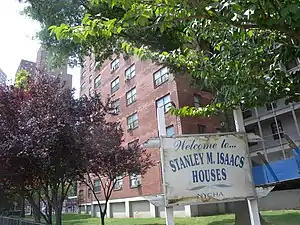
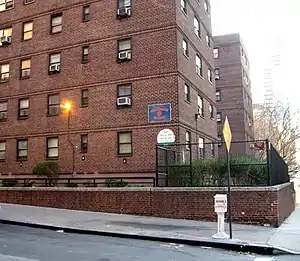
 Drew-Hamilton Houses, Harlem
Drew-Hamilton Houses, Harlem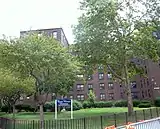 East River Houses, Spanish Harlem
East River Houses, Spanish Harlem Harborview, Hell's Kitchen
Harborview, Hell's Kitchen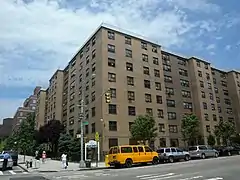 Metro North Plaza, Spanish Harlem
Metro North Plaza, Spanish Harlem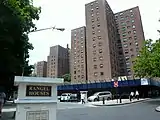 Rangel Houses, Harlem
Rangel Houses, Harlem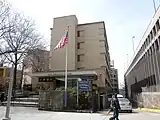 Fort Washington Ave. Rehab, Washington Heights
Fort Washington Ave. Rehab, Washington Heights
Manhattan
| NYCHA Property | Neighborhood/Subsection | No.# of Buildings | No.# of Stories | No.# of Apartments | Date of Completion | Date of Demolition | Notes |
|---|---|---|---|---|---|---|---|
| Alfred E. Smith Houses | Lower East Side | 12 | 17 | 1,931 | October 30, 1950 | ||
| Audubon Houses | Washington Heights | 1 | 20 | 167 | April 30, 1962 | ||
| Amsterdam Addition | Upper West Side | 1 | 27 | 175 | January 31, 1974 | ||
| Amsterdam Houses | Upper West Side | 13 | 6 and 13 | 1,080 | December 17, 1948 | ||
| Baruch Addition | Lower East Side | 1 | 23 | 197 | April 30, 1977 | Senior-Only Housing | |
| Baruch Houses | Lower East Side | 17 | 8 and 14 | 2,193 | June 30, 1959 | ||
| Bethune Gardens | Washington Heights | 1 | 22 | 210 | March 31, 1967 | ||
| Bracetti Plaza | East Village | 1 | 7 | 108 | May 31, 1974 | ||
| Campos Plaza | East Village | 2 | 10 and 20 | 270 | September 30, 1979 | ||
| Carver Houses | East Harlem | 13 | 6 and 15 | 1,246 | January 31, 1958 | ||
| Chelsea Houses | Chelsea | 2 | 21 | 426 | May 31, 1964 | Combined with Elliott Houses | |
| Chelsea Addition | Chelsea | 1 | 14 | 96 | April 30, 1968 | Senior-Only Housing; Combined with Elliot Houses | |
| Clinton Houses | East Harlem | 6 | 9 and 18 | 749 | October 31, 1965 | ||
| Corsi Houses | East Harlem | 1 | 16 | 171 | November 30, 1973 | Senior-Only Housing | |
| De Hostos Apartments | Upper West Side | 1 | 22 | 219 | February 28, 1969 | ||
| Drew Hamilton Houses | Harlem | 5 | 21 | 1,207 | September 30, 1965 | ||
| Dyckman Houses | Inwood | 7 | 14 and 15 | 1,167 | April 25, 1951 | ||
| East River Houses | East Harlem | 10 | 6, 10 and 11 | 1,158 | May 20, 1941 | ||
| Elliott Houses | Chelsea | 4 | 11 and 12 | 608 | July 15, 1947 | ||
| Fabria Houses | East Village | 3 | 5 | 40 | May 1, 1985 | ||
| First Houses | East Village | 8 | 4 and 5 | 126 | May 31, 1936 | Oldest public housing development out of all of the boroughs in the city. | |
| Fort Washington Avenue Rehab | Washington Heights | 1 | 7 | 226 | September 30, 1984 | Senior-Only Housing | |
| Frederick Douglass Addition | Upper West Side | 1 | 16 | 135 | June 30, 1965 | ||
| Frederick Douglass Houses | Upper West Side | 17 | 5, 9, 12, 17, 18 and 20 | 2,054 | May 31, 1958 | ||
| Frederick E. Samuel Apartments | Harlem | 40 | 5, 6 and 7 | 659 | June 30, 1993 | ||
| Fulton Houses | Chelsea | 11 | 6 and 25 | 945 | March 31, 1965 | ||
| Gompers Houses | Lower East Side | 2 | 20 | 474 | April 30, 1964 | ||
| Grampion Houses | Harlem | 1 | 7 | 35 | May 31, 1977 | ||
| Grant Houses | Manhattanville | 9 | 13 and 21 | 1,940 | September 30, 1957 | ||
| Harborview Terrace | Clinton | 2 | 14 and 15 | 377 | June 30, 1977 | ||
| Harlem River Houses | Harlem | 7 | 4 and 5 | 571 | October 1, 1937 | ||
| Hernandez Houses | Lower East Side | 1 | 17 | 149 | August 31, 1971 | ||
| Holmes Towers | Yorkville | 2 | 25 | 537 | April 30, 1969 | ||
| Isaacs Houses | Yorkville | 3 | 24 | 635 | July 31, 1965 | ||
| Jackie Robinson Houses | East Harlem | 1 | 8 | 189 | May 31, 1973 | ||
| Jefferson Houses | East Harlem | 18 | 7, 13 and 14 | 1,487 | June 30, 1959 | ||
| Johnson Houses | East Harlem | 10 | 14 | 1,308 | December 27, 1948 | ||
| King Towers | Harlem | 10 | 13 and 14 | 1,373 | October 31, 1954 | ||
| LaGuardia Addition | Lower East Side | 1 | 16 | 150 | August 31, 1965 | Senior-Only Housing | |
| LaGuardia Houses | Lower East Side | 9 | 16 | 1,093 | July 31, 1957 | ||
| Lehman Village | East Harlem | 4 | 20 | 619 | November 30, 1963 | ||
| Lexington Houses | Harlem | 4 | 14 | 448 | March 16, 1951 | ||
| Lincoln Houses | Harlem | 14 | 6 and 14 | 1,282 | December 29, 1948 | ||
| Lower East Side II | Lower East Side | 4 | 3 | 188 | November 1, 1988 | ||
| Lower East Side III | Lower East Side | 2 | 4 | 56 | April 30, 1997 | ||
| Lower East Side Rehab | Lower East Side | 2 | 6 | 55 | December 1, 1986 | ||
| Lower East Side I Infill | Lower East Side | 5 | 4 and 9 | 189 | April 30, 1988 | ||
| Manhattanville Houses | Manhattanville | 6 | 19, 20 and 21 | 1,272 | June 30, 1961 | ||
| Marshall Plaza | Washington Heights | 1 | 20 | 180 | June 30, 1986 | ||
| Meltzer Tower | East Village | 1 | 20 | 230 | August 31, 1971 | ||
| Metro North Plaza | East Harlem | 3 | 7, 8 and 11 | 269 | August 31, 1971 | ||
| Metro North Rehab | East Harlem | 17 | 6 | 321 | September 30, 1989 | ||
| Milbank-Frawley | East Harlem | 2 | 5 and 6 | 82 | July 31, 1988 | ||
| Polo Grounds Towers | Harlem | 4 | 30 | 1,614 | June 30, 1968 | ||
| Rangel Houses | Harlem | 8 | 14 | 984 | September 30, 1951 | ||
| Riis Houses | East Village | 13 | 6, 13 and 14 | 1,187 | January 17, 1949 | ||
| Riis II | East Village | 6 | 6, 13 and 14 | 577 | January 31, 1949 | ||
| Robbins Plaza | Lenox Hill | 1 | 20 | 150 | February 28, 1975 | Senior-Only Housing | |
| Robert F. Wagner Houses | East Harlem | 22 | 7 and 16 | 2,154 | May 31, 1958 | ||
| Rutgers Houses | Lower East Side | 5 | 20 | 721 | March 31, 1965 | ||
| St. Nicholas Houses | Harlem | 13 | 14 | 1,523 | September 30, 1954 | ||
| Straus Houses | Rose Hill | 2 | 19 and 20 | 267 | January 31, 1965 | ||
| Taft Houses | East Harlem | 9 | 19 | 1,464 | December 31, 1962 | ||
| Two Bridges URA (SITE 7) | Two Bridges | 1 | 26 | 250 | April 30, 1975 | ||
| Vladeck Houses I | Lower East Side | 20 | 6 | 250 | November 25, 1940 | ||
| Vladeck Houses II | Lower East Side | 4 | 6 | 238 | October 25, 1940 | ||
| Wald Houses | Lower East Side | 16 | 10, 11, 13 and 14 | 1,857 | October 14, 1949 | ||
| Washington Houses | East Harlem | 14 | 12 and 14 | 1,510 | July 31, 1957 | ||
| Wilson Houses | East Harlem | 3 | 20 | 398 | June 30, 1961 | ||
| Wise Houses | Upper West Side | 2 | 19 | 399 | January 31, 1965 | ||
| WSUR Brownstones | Upper West Side | 36 | 3, 4, and 6 | 236 | June 30, 1968 | ||
Bronx
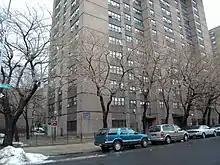 Betances Houses, Mott Haven
Betances Houses, Mott Haven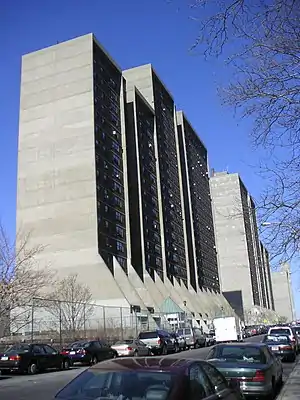
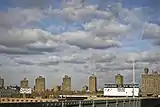 Millbrook Houses, Mott Haven
Millbrook Houses, Mott Haven Morris Houses, Morrisania
Morris Houses, Morrisania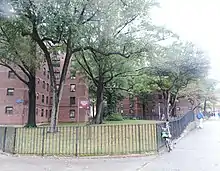 Pelham Pkwy Houses, Pelham Parkway
Pelham Pkwy Houses, Pelham Parkway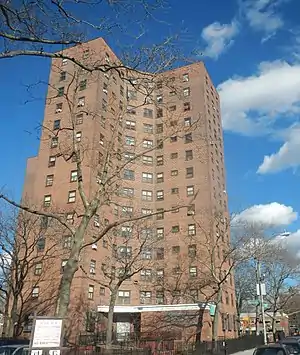
 Sedgwick Houses, Morris Heights
Sedgwick Houses, Morris Heights
| NYCHA Property | Neighborhood/Subsection | No.# of Buildings | No.# of Stories | No.# of Apartments | Date of Completion | Date of Demolition | Notes |
|---|---|---|---|---|---|---|---|
| 1010 East 178th Street | West Farms | 1 | 21 | 218 | March 31, 1971 | ||
| 1162-1176 Washington Avenue | Morrisania | 1 | 6 | 64 | December 31, 1975 | ||
| 1471 Watson Avenue | Soundview | 1 | 6 | 96 | December 31, 1970 | ||
| Adams Houses | Melrose | 7 | 15 and 21 | 925 | August 31, 1964 | ||
| Bailey Avenue-West 193rd Street | University Heights | 1 | 19 | 232 | May 31, 1973 | ||
| Baychester Houses | Edenwald | 11 | 6 | 441 | May 31, 1963 | ||
| Dr. Ramon E. Betances I | Mott Haven | 13 | 3, 4, 11 and 19 | 308 | May 31, 1973 | ||
| Dr. Ramon E. Betances II, 13 | Mott Haven | 1 | 6 | 51 | July 31, 1973 | ||
| Dr. Ramon E. Betances II, 18 | Mott Haven | 2 | 4 and 6 | 51 | July 31, 1973 | ||
| Dr. Ramon E. Betances II, 9A | Mott Haven | 1 | 4 | 46 | July 31, 1973 | ||
| Dr. Ramon E. Betances III, 13 | Mott Haven | 2 | 5 | 22 | July 31, 1973 | ||
| Dr. Ramon E. Betances III, 18 | Mott Haven | 1 | 5 | 19 | July 31, 1973 | ||
| Dr. Ramon E. Betances III, 9A | Mott Haven | 2 | 6 | 26 | July 31, 1973 | ||
| Dr. Ramon E. Betances IV | Mott Haven | 8 | 3, 4 and 5 | 282 | December 31, 1973 | ||
| Dr. Ramon E. Betances V | Mott Haven | 9 | 5 and 6 | 152 | February 28, 1974 | ||
| Dr. Ramon E. Betances VI | Mott Haven | 3 | 5 and 6 | 155 | September 30, 1982 | ||
| Baychester Houses | Edenwald | 11 | 6 | 441 | May 31, 1963 | ||
| Boston Road Plaza Houses | Bronxdale | 1 | 20 | 230 | August 31, 1972 | ||
| Boston Secor Houses | Eastchester | 4 | 13, 14, 17 and 18 | 538 | April 30, 1969 | ||
| Boynton Avenue Rehabs | Soundview | 3 | 4 | 20 | 1928 | ||
| Bronx River Addition | Soundview | 2 | 6 and 12 | 225 | February 28, 1966 | ||
| Bronx River Houses | Soundview | 9 | 14 | 1,260 | February 28, 1951 | ||
| Bronxchester Houses | Melrose | 1 | 18 | 208 | June 30, 1978 | ||
| Bryant Avenue-East 174th Street | Crotona Park East | 1 | 6 | 111 | 1973 | ||
| Butler Houses | Morrisania | 6 | 21 | 1,476 | December 31, 1964 | ||
| Castle Hill Houses | Castle Hill | 14 | 12 and 20 | 2,025 | November 30, 1960 | ||
| Claremont Parkway-Franklin Avenue Area | Morrisania | 3 | 3 and 7 | 1,888 | December 31, 1986 | ||
| Claremont Rehab (Group 2) | Concourse | 6 | 5 and 6 | 107 | April 30, 1987 | ||
| Claremont Rehab (Group 3) | Concourse | 5 | 5 | 112 | December 31, 1984 | ||
| Claremont Rehab (Group 4) | Concourse | 9 | 4 and 5 | 150 | October 31, 1986 | ||
| Claremont Rehab (Group 5) | Concourse | 3 | 5 | 132 | November 30, 1985 | ||
| Clason Point Gardens | Soundview | 45 | 2 | 433 | 1941 | Oldest public housing development in the borough. | |
| College Avenue-East 165th Street | Concourse | 1 | 6 | 95 | 1972 | ||
| Davidson Houses | Morrisania | 1 | 8 | 177 | August 31, 1973 | ||
| Eagle Avenue-East 165th Street | Morrisania | 1 | 6 | 66 | May 31, 1971 | ||
| East 152nd Street-Courtlandt Avenue | Melrose | 2 | 11 and 14 | 1973 | |||
| East 165th Street-Bryant Avenue | Longwood | 5 | 3 | 111 | 1987 | ||
| East 173rd Street-Vyse Avenue | East Morrisania | 7 | 3 | 1995 | |||
| East 180th Street-Monterey Avenue | East Tremont | 1 | 10 | 239 | September 30, 1973 | ||
| Edenwald Houses | Edenwald | 40 | 3 and 14 | 2,034 | October 15, 1953 | Largest public housing development in the borough. | |
| Forest Houses | Morrisania | 15 | 9, 10 and 14 | 1,349 | December 31, 1956 | ||
| Fort Independence Street-Heath Avenue | Kingsbridge Heights | 1 | 21 | 344 | November 30, 1974 | ||
| Franklin Avenue I (Conventional) | Morrisania | 3 | 5 | 1910 | |||
| Franklin Avenue I M.H.O.P. (Multi Family Homeownership Program) | Morrisania | 2 | 5 | 1910 | |||
| Franklin Avenue II (Conventional) | Morrisania | 3 | 5 | 1910 | |||
| Franklin Avenue III (Conventional) | Morrisania | 1 | 5 | 1910 | |||
| Franklin Avenue III M.H.O.P. (Multi Family Homeownership Program) | Morrisania | 3 | 5 | 1910 | |||
| Glebe Avenue-Westchester Avenue | Westchester Square | 1 | 6 | 132 | December 31, 1971 | ||
| Gun Hill Houses | Williamsbridge | 6 | 13, 14 and 15 | 733 | November 30, 1950 | ||
| Harrison Avenue Rehab (Group A) | Morris Heights | 1 | 5 | 1926 | |||
| Harrison Avenue Rehab (Group B) | Morris Heights | 4 | 4 and 5 | 1926 | |||
| Highbridge Gardens | Highbridge | 6 | 13 and 14 | 699 | June 30, 1954 | ||
| Highbridge Rehabs (West 166th Street-Anderson Avenue) | Highbridge | ||||||
| Highbridge Rehabs (Nelson Avenue) | Highbridge | ||||||
| Hoe Avenue-East 173rd Street | East Morrisania | 1 | 6 | ||||
| Jackson Houses | Melrose | 7 | 16 | 867 | July 31, 1963 | ||
| Jennings Street M.H.O.P. (Multi Family Homeownership Program) | Morrisania | 3 | 5 | ||||
| Longfellow Avenue Rehab | Longwood | 2 | 5 | 75 | June 30, 1990 | ||
| Macombs Road | Morris Heights | ||||||
| Marble Hill Houses | Marble Hill | 11 | 14 and 15 | 1,682 | March 3, 1952 | ||
| McKinley Houses | Morrisania | 5 | 16 | 1,633 | July 31, 1962 | ||
| Melrose Houses | Melrose | 8 | 14 | 1,020 | March 3, 1952 | ||
| Middleton Plaza | Pelham Bay | 1 | 15 | 178 | August 31, 1973 | ||
| Mill Brook Houses | Mott Haven | 9 | 16 and 17 | 1,255 | May 31, 1959 | ||
| Mill Brook Extension | Mott Haven | 1 | 16 | 125 | January 31, 1962 | ||
| Mitchell Houses | Mott Haven | 10 | 17, 19 and 20 | 1,729 | February 28, 1966 | ||
| Monroe Houses | Soundview | 12 | 8, 14 and 15 | 1,102 | September 30, 1961 | ||
| Moore Houses | Mott Haven | 2 | 20 | 463 | March 31, 1964 | ||
| Morris Heights Rehab | Morris Heights | ||||||
| Morris I | Morrisania | 10 | 16, 17 and 20 | 1,084 | August 31, 1965 | ||
| Morris II | Morrisania | 7 | 16, 17 and 20 | 801 | August 31, 1965 | ||
| Morrisania Air Rights | Melrose | 3 | 19, 23 and 29 | 843 | February 29, 1980 | ||
| Morrisania Houses | Morrisania | 2 | 16 And 17 | 205 | May 31, 1963 | ||
| Mott Haven Houses | Mott Haven | 8 | 20 and 22 | 993 | March 31, 1965 | ||
| Murphy Houses | East Morrisania | 2 | 20 | 281 | March 31, 1964 | ||
| Parkside Houses | Allerton | 14 | 6, 7, 14 and 15 | 879 | June 12, 1951 | ||
| Patterson Houses | Mott Haven | 15 | 6 and 13 | 1,788 | December 31, 1950 | ||
| Pelham Parkway Houses | Pelham Parkway | 23 | 6 | 1,266 | June 30, 1950 | ||
| Prospect Avenue M.H.O.P. (Multi Family Homeownership Program) | Morrisania | 1 | 5 | ||||
| PSS Grandparent Family Apartments | Morrisania | 1 | 6 | ||||
| Randall-Balcom Houses | Throgs Neck | 3 | 6 | 230 | 1971 | ||
| Sack Wern Houses | Soundview | 7 | 6 | 410 | May 31, 1977 | ||
| Saint Mary's Park Houses | Melrose | 6 | 21 and 22 | 1,007 | April 30, 1959 | ||
| Sedgwick Houses | Morris Heights | 7 | 14 and 15 | 784 | March 23, 1951 | ||
| Sotomayor Houses | Soundview | 28 | 7 | 1,496 | January 31, 1955 | Originally known as Bronxdale Houses. | |
| Soundview Houses | Soundview | 13 | 7 | 1,255 | December 31, 1954 | ||
| South Bronx Area (Site 402) | Melrose | 4 | 3 | 1986 | |||
| Southern Boulevard M.H.O.P. (Multi Family Homeownership Program) | Mott Haven | ||||||
| Stebbins Avenue-Hewitt Place | Longwood | 2 | 3 | 1986 | |||
| Teller Avenue-East 166th Street | Concourse | 1 | 6 | 91 | 1972 | ||
| Throggs Neck Addition | Throgs Neck | 4 | 8 and 11 | 287 | September 30, 1971 | ||
| Throggs Neck Houses | Throgs Neck | 29 | 3 and 7 | 1,185 | November 30, 1953 | ||
| Twin Park East (Site 9) Houses | East Tremont | 1 | 14 | 219 | November 30, 1981 | ||
| Twin Park West (Site 1 and 2) Houses | Tremont | 1 | 16 | 312 | September 30, 1974 | ||
| Union Avenue-East 163rd Street | Morrisania | 1 | 9 | 200 | March 31, 1985 | ||
| Union Avenue-East 166th Street | Morrisania | 6 | 3 | 120 | April 30, 1988 | ||
| University Avenue Rehab | Morris Heights | 4 | 6 | 230 | January 31, 1985 | ||
| Webster Houses | Morrisania | 5 | 21 | 605 | September 30, 1965 | ||
| West Farms Square Rehab | East Morrisania | 4 | 6 | 1915 | |||
| West Farms Square (Conventional) | East Morrisania | 1 | 5 | 1915 | |||
| West Farms Square M.H.O.P. (Multi Family Homeownership Program) | East Morrisania | 2 | 5 and 6 | 1915 | |||
| West Tremont Avenue-Sedgwick Avenue Area | Morris Heights | 1 | 11 | 148 | July 31, 1973 | ||
| West Tremont Rehab (Group 1) | Morris Heights | 2 | 5 and 6 | 97 | March 31, 1983 | ||
| West Tremont Rehab (Group 2) | Morris Heights | 2 | 6 | 99 | May 31, 1989 | ||
| West Tremont Rehab (Group 3) | Morris Heights | 3 | 5 | 88 | May 31, 1989 | ||
Brooklyn
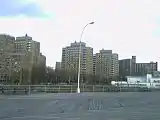 Coney Island Houses, Coney Island
Coney Island Houses, Coney Island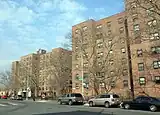 Cooper Park Houses, East Williamsburg
Cooper Park Houses, East Williamsburg Ingersoll Houses, Fort Greene
Ingersoll Houses, Fort Greene Lafayette Houses, Clinton Hill
Lafayette Houses, Clinton Hill Marlboro Houses, Gravesend
Marlboro Houses, Gravesend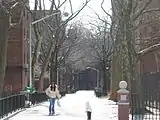 Sheepshead Houses, Sheepshead Bay
Sheepshead Houses, Sheepshead Bay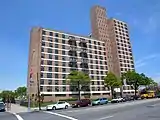 Unity Tower, Coney Island
Unity Tower, Coney Island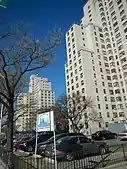 Wyckoff Gardens, Boerum Hill
Wyckoff Gardens, Boerum Hill
Vanderveer Estates Apartments nka Flatbush Gardens,[6] Tiffany Towers nka Tivoli Towers,[7] Ebbets Field Apartments[8] and Towers of Bay Ridge[9] and Rutland Rd Houses in Brooklyn, all five includes rent, gas & electric (AC including) in the lease, so it's not projects or developments owned by NYCHA, even though all five take Section 8.
| NYCHA Property | Neighborhood/Subsection | No.# of Buildings | No.# of Stories | No.# of Apartments | Date of Completion | Date of Demolition | Notes |
|---|---|---|---|---|---|---|---|
| 104-14 Tapscott Street | Brownsville | 1 | 4 | 30 | October 31, 1972 | ||
| 303 Vernon Avenue | Bedford-Stuyvesant | 1 | 24 | 234 | May 31, 1967 | ||
| 572 Warren Street | Boerum Hill | 1 | 6 | 1971 | |||
| Albany Houses I | Crown Heights | 6 | 14 | 824 | October 2, 1950 | ||
| Albany Houses II | Crown Heights | 3 | 13 and 14 | 396 | January 31, 1957 | ||
| Armstrong Houses I | Bedford-Stuyvesant | 11 | 4 and 6 | 369 | May 31, 1973 | ||
| Armstrong Houses II | Bedford-Stuyvesant | 5 | 5 | 248 | October 31, 1974 | ||
| Atlantic Terminal Site 4B | Fort Greene | 1 | 31 | 300 | April 30, 1976 | The tallest residential property owned by NYCHA, reaching 31 stories. | |
| Bay View Houses | Canarsie | 23 | 8 | 1,610 | May 31, 1956 | ||
| Belmont-Sutter Area | East New York | 3 | 3 | 72 | February 28, 1986 | ||
| Bernard Haber Houses | Coney Island | 3 | 14 | 380 | June 30, 1965 | ||
| Berry Street-South 9th Street | Williamsburg | 4 | 3 and 6 | 148 | September 30, 1995 | ||
| Borinquen Plaza I | Williamsburg | 8 | 7 | 509 | February 28, 1975 | ||
| Borinquen Plaza II | Williamsburg | 7 | 7 | 425 | December 31, 1975 | ||
| Boulevard Houses | East New York | 18 | 6 and 14 | 1,436 | March 22, 1951 | Tallest six 14 story multi residential property from 1951 to 1960. | |
| Breukelen Houses | Canarsie | 30 | 3 and 7 | 1,595 | October 31, 1952 | ||
| Breevort Houses | Bedford-Stuyvesant | 13 | 7 | 894 | August 31, 1955[10] | ||
| Brown Houses | Ocean Hill | 2 | 6 | 200 | July 31, 1985 | ||
| Brownsville Houses | Brownsville | 27 | 6 | 1,319 | April 16, 1948 | ||
| Bushwick-Hylan Houses | Williamsburg | 8 | 13 and 20 | 1,221 | March 31, 1960 | ||
| Bushwick II & Bushwick CDA | Bushwick | 5 | 3 | 276 | December 31, 1986 | ||
| Carey Gardens | Coney Island | 3 | 15 and 17 | 683 | November 30, 1970 | ||
| Crown Heights Houses | Crown Heights | 8 | 4 | 1910 | |||
| Coney Island Houses | Coney Island | 5 | 14 | 535 | January 31, 1957 | ||
| Cooper Park Houses | East Williamsburg | 11 | 7 | 699 | June 8, 1953 | ||
| Cypress Hills Houses | East New York | 15 | 7 | 1,442 | May 31, 1955 | ||
| East New York City Line Houses | East New York | 33 | 3 | 63 | March 31, 1976 | ||
| Farragut Houses | Downtown Brooklyn | 10 | 13 and 14 | 1,390 | April 30, 1952 | ||
| Fenimore Houses | East Flatbush | 18 | 2 | 36 | September 30, 1969 | ||
| Fiorentino Houses | East New York | 8 | 4 | 160 | October 31, 1971 | ||
| Glenmore Plaza | Brownsville | 4 | 10, 18, and 24 | 438 | April 30, 1968 | ||
| Glenwood Houses | Flatlands | 20 | 6 | 1,187 | July 14, 1950 | ||
| Gowanus Houses | Gowanus | 14 | 4, 6, 9 and 13 | 1,134 | June 14, 1949 | ||
| Gravesend Houses | Coney Island | 15 | 7 | 634 | June 30, 1954 | ||
| Hope Gardens | Bushwick | 4 | 7 and 14 | 324 | August 31, 1981 | Hosts Left Hook NYC in its community center | |
| Howard Houses | Brownsville | 10 | 7 and 13 | 814 | December 31, 1955 | ||
| Howard Av. Houses | Crown Heights | 8 | 3 | 1992 | |||
| Howard Av.-Park Place | Crown Heights | 8 | 3 | 155 | August 31, 1994 | ||
| Independence Towers | Williamsburg | 6 | 21 | 744 | October 31, 1965 | ||
| Ingersoll Houses | Fort Greene | 20 | 6 and 11 | 1,802 | February 24, 1944 | ||
| Johnathan Williams Plaza | Williamsburg | 5 | 14 and 21 | 577 | April 15, 1964 | ||
| Kingsborough Houses-Kingsborough Extension | Crown Heights | 16 | 6 | 1,148 | October 31, 1941 | ||
| Lafayette Gardens | Clinton Hill | 7 | 13, 15 and 20 | 880 | July 31, 1962 | ||
| Langston Hughes Apartments | Brownsville | 3 | 22 | 508 | June 30, 1968 | ||
| Lenox Road-Rockaway Parkway | Brownsville | 3 | 4 | 74 | May 31, 1985 | ||
| Linden Houses | East New York | 19 | 8 and 14 | 1,586 | June 30, 1958 | ||
| Long Island Baptist Houses | East New York | 4 | 6 | 233 | June 30, 1981 | ||
| Louis Heaton Pink Houses | East New York | 22 | 8 | 1,500 | September 30, 1959 | ||
| Marcus Garvey Houses | Brownsville | 3 | 6 and 14 | 321 | February 28, 1975 | ||
| Marcy Houses | Bedford-Stuyvesant | 27 | 6 | 1,705 | January 19, 1949 | ||
| Marcy-Greene Avs. Houses | Bedford-Stuyvesant | 3 | 3 | 1994 | |||
| Marlboro Houses | Gravesend | 28 | 7 and 16 | 1,765 | January 31, 1958 | ||
| Nostrand Houses | Marine park | 16 | 6 | 1,148 | December 14, 1950 | ||
| O'Dwyer Gardens Houses | Coney Island | 6 | 15 and 16 | 573 | December 31, 1969 | ||
| Ocean Hill Apartments | Ocean Hill | 3 | 14 | 236 | March 31, 1968 | ||
| Ocean Hill-Brownsville | Ocean Hill-Brownsville | 5 | 4 | 1910 | |||
| Palmetto Gardens | Bushwick | 1 | 6 | 115 | March 31, 1977 | ||
| Penn. Av. Rehab. | East New York | ||||||
| Penn.-Wortman Avs. Houses | East New York | 3 | 8 and 16 | 336 | September 30, 1972 | ||
| Park Rock Rehab. | Crown Heights | 9 | 4 | 134 | February 28, 1986 | ||
| Prospect Plaza | Ocean Hill | 4 | 12 and 15 | 368 | June 30, 1974 | Summer of 2014 | First NYCHA development to be demolished |
| Ralph Av. Rehab | Brownsville | 5 | 4 | 118 | December 31, 1986 | ||
| Red Hook East Houses | Red Hook | 27 | 2 and 6 | 2,528 | November 20, 1939 | ||
| Red Hook West Houses | Red Hook | 3 | 3 and 14 | 345 | May 31, 1955 | the location of the 1991 film, Straight Out of Brooklyn | |
| Roosevelt Houses | Bedford-Stuyvesant | 6 | 14, 15 and 16 | 762 | September 30, 1964 | ||
| Rutland Towers | East Flatbush | 1 | 6 | 61 | May 31, 1977 | ||
| Saratoga Square | Bedford-Stuyvesant | 2 | 12 and 13 | 251 | November 30, 1980 | ||
| Seth Low Houses | Brownsville | 4 | 17 and 18 | 536 | December 31, 1967 | ||
| Sheepshead Bay Houses | Sheepshead Bay | 18 | 6 | 1,056 | August 8, 1950 | ||
| Sterling Pl. Rehabs | Crown Heights | 5 | 4 | 83 | January 31, 1991 | ||
| Sumner Houses | Bedford-Stuyvesant | 13 | 7 and 12 | 1,098 | April 30, 1958 | ||
| Stuyvesant Gardens I | Bedford-Stuyvesant | 5 | 4 | 330 | August 31, 1972 | ||
| Stuyvesant Gardens II | Bedford-Stuyvesant | 1 | 7 | 150 | February 28, 1986 | ||
| Surfside Gardens | Coney Island | 5 | 14 and 15 | 597 | June 30, 1969 | ||
| Tapscott St. Rehab | Brownsville | 8 | 4 | 155 | January 31, 1986 | ||
| Tilden Houses | Brownsville | 8 | 16 | 998 | June 30, 1961 | ||
| Tompkins Houses | Bedford-Stuyvesant | 8 | 8 and 16 | 1,048 | July 31, 1964 | ||
| Taylor/Wythe Houses | Williamsburg | 5 | 8, 11, 12 and 13 | 525 | June 30, 1974 | ||
| Unity Plaza | East New York | 5 | 6 | 462 | November 30, 1973 | ||
| Van Dyke Houses | Brownsville | 22 | 3 and 14 | 1,602 | May 31, 1955 | the location of the 2010 film, Brooklyn's Finest | |
| Vandalia Av. Houses | East New York | 2 | 10 | 289 | May 31, 1983 | ||
| Vernon Houses | Bedford-Stuyvesant | ||||||
| Walt Whitman Houses | Fort Greene | 15 | 6 and 13 | 1,636 | February 24, 1944 | ||
| Weeksville Gardens | Crown Heights | 2 | 4 and 5 | 257 | April 30, 1974 | ||
| William Reid Houses | East Flatbush | 1 | 20 | 228 | November 30, 1969 | ||
| Williamsburg Houses | Williamsburg | 20 | 4 | 1,620 | April 10, 1938 | Oldest public housing development in the borough. | |
| Woodson Houses | Brownsville | 2 | 10 and 25 | 407 | August 31, 1970 | ||
| Wyckoff Gardens | Boerum Hill | 3 | 21 | 528 | December 31, 1966 | ||
Queens
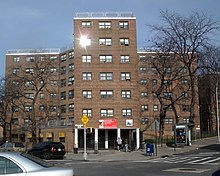

| NYCHA Property | Neighborhood/Subsection | No.# of Buildings | No.# of Stories | No.# of Apartments | Date of Completion | Date of Demolition | Notes | |
|---|---|---|---|---|---|---|---|---|
| Astoria Houses | Astoria | 22 | 6 and 7 | 1,102 | November 9, 1951 | |||
| Baisley Park Houses | South Jamaica | 5 | 8 | 385 | April 30, 1961 | |||
| Beach 41st Street-Beach Channel Drive Houses | Far Rockaway | 4 | 13 | 712 | November 30, 1973 | |||
| Bland Houses | Flushing | 5 | 10 | 400 | April 30, 1952 | |||
| Carleton Manor | Arverne | 1 | 11 | 170 | March 31, 1967 | |||
| Conlon L.I.H.F.E. Towers | Jamaica | 1 | 13 | 216 | March 31, 1971 | |||
| Forest Hills Co-op Houses | Forest Hills | 3 | 12 | 430 | November 30, 1975 | Left NYCHA in 2017 to become a tenant-managed co-op. | ||
| Hammel Houses | Rockaway Beach | 14 | 6 and 7 | 712 | April 30, 1955 | |||
| International Tower | South Jamaica | 1 | 10 | 153 | May 31, 1983 | |||
| Latimer Gardens | Flushing | 4 | 10 | 434 | September 30, 1970 | |||
| Leavitt House | Flushing | 1 | 6 | 83 | Oct 17, 1974 | managed by Latimer Gardens | ||
| Ocean Bay Apartments (Bayside) | Far Rockaway | 24 | 7 and 9 | 1,378 | September 25, 1961 | formerly known as Edgemere Houses | ||
| Ocean Bay Apartments (Oceanside) | Far Rockaway | 7 | 6 | 417 | February 28, 1951 | formerly known as Arverne Houses | ||
| Pomonok Houses | Flushing | 35 | 3, 7 and 8 | 2,070 | June 30, 1952 | |||
| Queensbridge Houses (North and South) | Long Island City | 26 | 6 | 3,142 | March 15, 1940 | the largest public housing complex in the United States. The oldest Public Housing development in Queens | ||
| Ravenswood Houses | Long Island City | 31 | 6 and 7 | 2,167 | July 31, 1951 | |||
| Redfern Houses | Far Rockaway | 9 | 6 and 7 | 604 | June 1, 1959 | |||
| Rehab Program | College Point | |||||||
| Shelton Houses | South Jamaica | 1 | 12 | 155 | October 31, 1978 | |||
| South Jamaica I Houses | South Jamaica | 11 | 3 and 4 | 440 | August 1, 1940 | |||
| South Jamaica II Houses | South Jamaica | 16 | 3 and 7 | 600 | October 25, 1954 | |||
| Woodside Houses | Woodside | 20 | 6 | 1,358 | December 30, 1949 | |||
Staten Island
| NYCHA Property | Neighborhood/Subsection | No.# of Buildings | No.# of Stories | No.# of Apartments | Date of Completion | Date of Demolition | Notes |
|---|---|---|---|---|---|---|---|
| Berry Houses | Dongan Hills | 8 | 6 | 506 | October 30, 1950 | ||
| Cassidy-Lafayette Houses | Randall Manor | 4 | 6 | 381 | September 30, 1971 | ||
| Mariners Harbor Houses | Mariners Harbor | 22 | 3 and 6 | 605 | August 31, 1954 | ||
| New Lane Shores Houses | Shore Acres | 1 | 10 | 304 | July 31, 1984 | ||
| Richmond Terrace Houses | New Brighton | 6 | 8 | 489 | October 12, 1964 | ||
| South Beach Houses | South Beach | 8 | 6 | 422 | March 20, 1950 | ||
| Stapleton Houses | Stapleton | 6 | 8 | 693 | May 31, 1962 | Largest public housing development in the borough. | |
| West Brighton Houses | West New Brighton | 8 | 8 | 490 | December 31, 1962 | ||
| Todt Hill Houses | Manor Heights | 7 | 6 | 502 | June 1, 1950 | ||
History
NYCHA was created in 1934 to help alleviate the housing crisis caused by the Great Depression during Mayor Fiorello H. LaGuardia's administration and was the first agency in the United States to provide publicly funded housing.[11][12][1] The agency used the developments to practice slum-clearance and establish model affordable housing for the city. In 1935, NYCHA completed its first development, the First Houses, located on the Lower East Side of Manhattan. The parcel of land the houses were located on were purchased from Vincent Astor and the city used eminent domain to secure the remaining property. However, the construction of the First Houses used existing apartment buildings to renovate which proved too costly.[13][1]
NYCHA's first two "new from the ground up" developments were Harlem River in 1937 and Williamsburg in 1938. Both are noted for their art-deco style of architecture, which are unique in public housing. These developments were segregated based on race with Harlem River being black-only and Williamsburg white-only.[13][1]
The Authority boomed in partnership with Robert Moses after World War II as a part of Moses' plan to clear old tenements and remake New York as a modern city. Moses indicated later in life that he was disappointed at how the public housing system fell into decline and disrepair. The majority of NYCHA developments were built between 1945 and 1965. Unlike most cities, New York depended heavily on city and state funds to build its housing after the Federal Housing Act of 1937 expired and a new bill wasn't agreed upon until the Federal Housing Act of 1949, rather than just the federal government.[14] Most of the postwar developments had over 1,000 apartment units each, and most were built in the modernist, tower-in-the-park style popular at the time. In the 1950s and 1960s, many New Yorkers, including supporters, became more critical of the agency and in response NYCHA introduced a new look that included variations of height, faster elevators, and larger apartments. In 1958, Mayor Robert F. Wagner Jr. began to shift construction away from megaprojects to smaller sites which retained the street grid and had under 1,000 units.[1]
In 1964, NYCHA ended a policy that held apartments for white tenants in an attempt to integrate the developments. Tenants organized a rent strike in opposition to the policy and the State Commission of Human Rights questioned if the policy was in accordance to the state's laws on discrimination.[15]
In 1995, the New York City Housing Authority Police Department and the New York City Transit Police were merged into the New York City Police Department by NYC Mayor Rudolph W. Giuliani and continues today as the New York City Police Department Housing Bureau.
Governance and operations
NYCHA is a public-benefit corporation, controlled by the Mayor of New York City, and organized under the State's Public Housing Law.[11][16] The NYCHA ("NYCHA Board") consists of seven members, of which the chairman is appointed by and serves at the pleasure of the Mayor of New York City, while the others are appointed for three-year terms by the mayor.[17] The board includes three members who are residents of public housing, and a board chair who also serves as NYCHA's chief executive officer.[18]
On September 15, 2022, Mayor Eric Adams announced a new two person leadership structure for NYCHA with a split between the NYCHA Chair and CEO roles, with the CEO managing the day-to-day operations and the Chair overseeing the NYCHA Board.
The Authority is the largest public housing authority (PHA) in North America. In spite of many problems, it is still considered by experts to be the most successful big-city public housing authority in the country. Whereas most large public housing authorities in the United States (Chicago, St. Louis, Baltimore, etc.) have demolished their high-rise projects and in most cases replaced them with lower density housing, New York's continue to be fully occupied. Most of its market-rate housing is also in high-rise buildings.
NYCHA also administers a citywide Section 8 Leased Housing Program in rental apartments. However, new applications for Section 8 have not been accepted since December 10, 2009.[19]
New York also maintains a long waiting list for its apartments. Because of demand, the Housing Authority in recent years, has selected more "working families" from applicants to diversify the income structure of occupants of its housing, as had been typical of residents who first occupied the facilities. NYCHA's Conventional Public Housing Program has 175,636 apartments (as of 2018) in 325 developments throughout the city.[20]
NYCHA has approximately 13,000 employees serving about 173,946 families and approximately 392,259 authorized residents.[20] Based on the 2010 census, NYCHA's Public Housing represents 8.2% of the city's rental apartments and is home to 4.9% of the city's population. NYCHA residents and Section 8 voucher holders combined occupy 12.4% of the city's rental apartments.[21]
List of chairpersons
| No. | Chairperson | Term | Mayor | Previous Position |
|---|---|---|---|---|
| 1. | Langdon Post | February 17, 1934 – December 1, 1937 | Fiorello H. La Guardia | U.S. Assistant Federal Relief Administrator |
| 2. | Alfred Rheinstein | December 17, 1937 – October 9, 1939 | Fiorello H. La Guardia | Chairman & CEO, Rheinstein Construction Company |
| 3. | Gerard Swope | December 11, 1939 – January 26, 1942 | Fiorello H. La Guardia | President, General Electric Company |
| 4. | Edmond Borgia Butler | May 2, 1942 – July 1, 1947 | Fiorello H. La Guardia | Professor, Fordham University Law School |
| 5. | Thomas Francis Farrell | July 1, 1947 – September 15, 1950 | William O'Dwyer | Chief of Field Operations, The Manhattan Project |
| 6. | Philip J. Cruise | September 15, 1950 – April 3, 1958 | Vincent R. Impellitteri (acting mayor) | Assistant Chairman, New York City Housing Authority |
| 7. | William Reid | April 1958 – December 31, 1965 | Robert F. Wagner Jr. | Chairman, Hudson and Manhattan Railroad |
| 8. | Missing Name | January 1966 – | ||
| 9. | Gerald J. Carey | 1966 | John V. Lindsay | General manager, New York City Housing Authority |
| 10. | Walter Edward Washington | 1966 – 1967 | John V. Lindsay | Exec. Dir. National Capital Housing Authority, DC |
| 11. | Albert Walsh | October 31, 1967 – January 7, 1970 | John V. Lindsay | Deputy Commissioner, NYS Division Housing & Urban Renewal |
| 12. | Simeon Golar | January 16, 1970 – May 31, 1973 | John V. Lindsay | Chairman, NYC Commission on Human Rights |
| 13. | Joseph J. Christian | 1973 – December 31, 1985 | John V. Lindsay, Abraham D. Beame, Edward I. Koch | Commissioner of Development, NYC Housing and Development Administration |
| 14. | Emanuel P. Popolizio | January 4, 1986 – November 1990 | Edward I. Koch | Chairman, NYC Conciliation and Appeals Board |
| 15. | Laura D. Blackburne | November 1990 – February 22, 1992 | David N. Dinkins | President & CEO, Institute for Mediation and Conflict Resolution, NYC |
| 16. | Sally B. Hernandez-Pinero | February 22, 1992 – January 1994 | David N. Dinkins | NYC Deputy Mayor for Finance and Economic Development |
| 17. | Ruben Franco | January 31, 1994 – January 7, 1999 | Rudy Giuliani | Pres. and General Counsel, Puerto Rican Legal Defense and Education Fund |
| 18. | John G. Martinez | April 19, 1999 – April 1, 2001 | Rudy Giuliani | First Vice-president, Paine Webber Inc. |
| 19. | Tino Hernandez | April 1, 2001 – December 12, 2008 | Rudy Giuliani, Michael R. Bloomberg | Commissioner, New York City Department of Juvenile Justice |
| 20. | Ricardo Elias Morales | December 15, 2008 – May 13, 2009 | Michael R. Bloomberg | NYCHA General Counsel & Chief Ethics Officer |
| 21. | John B. Rhea | June 1, 2009 – December 30, 2013 | Michael R. Bloomberg | Managing Director & Co-Head of Global Consumer/Retail Group, Barclays Capital |
| 22. | Shola Olatoye | February 8, 2014 – April 30, 2018[22] | Bill de Blasio | Vice Pres. & NY Market Leader, Enterprise Community Partners, Inc. |
| * | Derrick Cephas (Acting Chair*) | May 4, 2018 – May 31, 2018[23] | Bill de Blasio | Vice Chair of NYCHA Board of Directors |
| * | Stanley Brezenoff (Interim Chair & CEO*) | June 1, 2018 – February 15, 2019 | Bill de Blasio | Interim CEO, NYC Health and Hospitals Corporation |
| * | Kathryn Garcia (Interim Chair & CEO*) | February 5, 2019 – July, 2019 | Bill de Blasio | Commissioner, NYC Department of Sanitation (continuing as) |
| 23. | Gregory Russ | Appointed June 18, 2019, effective August 12, 2019 – September 19, 2022 | Bill de Blasio, Eric Adams | Executive director & CEO, Minneapolis Public Housing Authority |
| * | Lisa Bova-Hiatt (Interim CEO*) | September 19, 2022 – July 6, 2023 | Eric Adams | NYCHA Executive Vice President of Legal Affairs and General Counsel |
| 24. | Lisa Bova-Hiatt (CEO) Jamie Rubin (Board Chair) | July 6, 2023 – | Eric Adams | NYCHA Interim CEO (Lisa Bova-Hiatt), Chief Investment Officer (CIO) Aligned Climate Capital (Jamie Rubin) |
Capital needs
In 2004, NYCHA contracted with the Architectural/Engineering firm Parsons Brinckerhoff Quade and Douglas to perform a needs assessment survey of all 2500+ properties owned by the agency (excluding FHA Homes, which were inspected by in-house NYCHA personnel in about 2007). In 2005, a report was released detailing the conditions of every aspect and building component of each individual property, based on a scale of 1 to 5 (in this case, 1 being the highest or best rating, and 5 being the lowest, or poorest rating). This report identified $6.9 billion in needs required to bring the Authority's structures into a state of good repair. In 2011/12, a second needs assessment survey was done by PBQ&D, which identified $16.5 billion in needs. This represented an average of $93,000 per unit. It is anticipated that an upcoming needs assessment contract will reveal capital needs in excess of $25 billion.[24] The needs assessment survey is divided into five broad categories, which are: Architectural, Mechanical, Electrical, Site, and Apartments. Given the large number of apartment units within NYCHA, the report's findings on apartments are based upon an inspection of 5% of NYCHA's total inventory.
In mid-2007, NYCHA faced a $225 million budget shortfall.[25]
In late 2015, NYCHA announced the formation of the Fund for Public Housing,[26] a nonprofit organization that will seek to raise $200 million over three years to supplement NYCHA's efforts and improve the lives of NYC public housing residents. The Fund received its first donation of $100,000 from the Deutsche Bank in December 2015.[27] Also in 2015 Mayor Bill de Blasio released a plan called Next Gen NYCHA to address funding and maintenance concerns by "revamping management practices and generate revenue by building mixed-income and affordable housing on what the city deemed underused NYCHA land, and by using new federal programs to shift NYCHA apartments over to Section 8, a more stable source of federal funding".[28][29]
In 2018, a city-wide survey of NYCHA properties found that the organization needs $31.8 billion over five years to address unmet capital repairs including replacing broken elevators, upgrading faulty heating systems, and fix run-down kitchens and bathrooms. Despite its needed repairs, the Department of Housing and Urban Development (HUD) is cutting the agency's budget to encourage NYCHA to rely on partnerships with private property managers while Governor Andrew Cuomo is withholding his multiyear funding of $550 million until a federally required monitor is appointed to oversee the housing authority.[30] Later that year, the de Blasio administration announced a plan, called NYCHA 2.0, to address the capital needs of the agency which includes converting 62,000 NYCHA apartments into Section 8 and bringing in private management to oversee the backlog of repairs for the apartments, and selling air rights over NYCHA property to raise money.[31][32][29] The conversion of the properties would be under the Rental Assistance Demonstration (RAD) federal program leading to concerns that NYCHA would be privatized.[33][34] If units were to be brought under RAD, oversight by the monitor and the court would be terminated leading to further concerns that the mold remediation ordered in the 2013 Baez lawsuit wouldn't happen.[35]
In 2019, the administration, under NYCHA 2.0, began considering demolishing and rebuilding the Fulton Houses in Chelsea and the Cooper Park Houses in Williamsburg through partnering with private developers and a 70–30 split of market-rate and affordable housing.[36][37][38] Other developers began lobbying the city for air rights from Campos Plaza II, Fulton Houses, and the Ingersoll Houses.[39]
The approach of the administration, under NYCHA 2.0, is a turn back to Bloomberg-era initiatives of market rate infill that he once felt ignored the concerns of NYCHA residents after a failed trial of four buildings with a 50–50 split of market-rate and low-cost housing infill did not provide enough money under Next-Gen NYCHA.[40][41] Then in July, 2020 NYCHA announced a new plan called A Blueprint for Change which would transfer 110,000 apartments to a newly created public entity - a Public Housing Preservation Trust.[42] In February, 2021 the Chelsea NYCHA Working Group released their plan for the Elliott-Chelsea Houses and the Fulton Houses and the city released an RFP for it.[43][44]
Hurricane Sandy and its impact on NYCHA
In October, 2012, Hurricane Sandy turned out to be the single most destructive event in the history of the New York City Housing Authority. The storm impacted approximately 10% of NYCHA's developments, which left 400 buildings without power, and 386 buildings without heat and hot water.[45]
In February 2014, NYCHA's Recovery and Resilience Department was created bringing about initial agreements in over $3 billion in funding for over 33 developments by March 2015. In August 2015, the first construction began on Lower East Side V. In December 2015, NYCHA received $3 billion in disaster recovery funding and by December 2016, $201 million of construction was underway. By December 2017, $1.85 billion in contracts were awarded, and construction was underway at 27 developments. Construction at all Sandy-impacted sites are expected to be completed by the end of 2021.[45]
Lawsuits
Tenant lawsuit
In February 2018, attorney Jim Walden filed a lawsuit on behalf of 400,000 NYCHA tenants living in squalid conditions. The suit demands that the court appoint an independent monitor to oversee NYCHA because the agency failed to provide tenants with heat and hot water, keep residents safe from lead, involve tenants in policy-making, and hire residents, as required under federal law.[46] In April 2018, under intense pressure from the lawsuit, chairwoman Shola Olatoye resigned.[22]
Federal lawsuit
On June 11, 2018, U.S. Attorney Geoffrey Berman filed a lawsuit accusing NYCHA of violating health and safety regulations, exposing children to lead paint, and training its workers to deceive inspectors under the oversight of chairwoman Shola Olatoye from 2012 to 2016.[47][48] According to federal prosecutors, deceptions NYCHA workers used included shutting off buildings' water supplies during inspections to hide leaks and building false walls out of plywood to hide dilapidated rooms from inspectors.[47] That day, NYCHA settled the lawsuit by admitting to the allegations, agreeing to spend an additional $1 billion over the next four years, and by agreeing to oversight by a federal monitor.[47][49] In 2019, the federal government reached an agreement with the city to appoint a federal monitor and $2.2 billion spent by the city over the next decade on repair to avoid a federal takeover.[50] In February 2019, federal officials chose Bart Schwartz as the NYCHA monitor.[51]
Statistics
- 335 developments in New York City[52]
- Staten Island has 9 developments with 4,499 apartments
- Queens has 22 developments with 17,126 apartments
- The Bronx has 100 developments with 44,500 apartments
- Brooklyn has 98 developments with 58,669 apartments
- Manhattan has 102 developments with 53,890 apartments[21]
- The Bronx's largest development is Edenwald Houses in Edenwald with 2,036 apartments.
- Brooklyn's largest development is Red Hook Houses in Red Hook with 2,878 apartments.
- Queens's largest development is Queensbridge Houses in Long Island City with 3,142 apartments
- Manhattan's largest development is Baruch Houses on the Lower East Side with 2,391 apartments
- Staten Island's largest development is Stapleton Houses in Stapleton with 693 apartments.[21]
- 10 developments consisting of FHA Acquired Homes are located in more than one borough and total 200 apartments
- 42 developments are for seniors only; 15 seniors-only buildings exist within mixed-population developments
- NYCHA has approximately 9,822 apartments designated for seniors only
- There also are 7,639 retrofitted apartments for families of persons who are mobility impaired as of September 30, 2007
- As of April 13, 2017: 14 developments are at least 70 years old; a total of 60 developments are 60 to 69 years old; there are 75 developments 50 to 59 years old; another 89 developments are 40 to 49 years old, and 52 developments are 30 to 39 years old.
- The combined demographics of all public housing developments in New York City is about 46% Black, 44% Hispanic, 4% White, 5% Asian, and 1% other.[53]
- NYCHA residents in Chelsea earn significantly less money than the average Chelsea resident and are almost half as likely to have a college degree.[5]
- The Queensbridge Houses in Long Island City, Queens, is now North America's largest housing project with 3,142 apartments, following the demolition of several larger Chicago housing projects, including the Cabrini–Green Homes and the Robert Taylor Homes (whose 4,321 three, four and five bedroom apartments once made it the largest public housing project in the world).[54]
- Brownsville, Brooklyn has the highest concentration of low income public housing in America, following the demolition of a huge 5-mile long tract of public housing stretching along State and Federal on Chicago's South Side. While pre-Plan For Transformation Chicago Housing Authority high-rise developments tended to be much larger and more concentrated than those of the NYCHA, the NYCHA operates several times as many apartments and houses three times as many residents. East Harlem in Manhattan has the second highest concentration of public housing in the nation, closely following Brownsville.
See also
- Public housing in the United States
- Mitchell-Lama Housing Program
- La Guardia and Wagner Archives
- Rent control in New York
- Developing Lives
- New York City Department of Housing Preservation and Development
- Project Lives
 Panorama of NYCHA houses
Panorama of NYCHA houses
References
- Bloom, Nicholas Dagen; Lasner, Matthew Gordon (2016). Affordable Housing in New York: The People, Places, and Policies That Transformed a City. Princeton University Press. ISBN 9780691167817.
- "NYCHA Fact Sheet 2021" (PDF). Retrieved 2021-09-24.
- "NYCHA - About". www1.nyc.gov. Retrieved 2021-09-24.
- "NYCHA Fact Sheet 2023" (PDF). Retrieved 2023-06-25.
- "Archived copy" (PDF). Archived from the original (PDF) on 2016-08-08. Retrieved 2016-07-12.
{{cite web}}: CS1 maint: archived copy as title (link) - "Flatbush Gardens Brooklyn Apartments - Apartments in Brooklyn, NY". www.flatbushgardens.net.
- "Tivoli Towers Apartments - Brooklyn, NY". Apartments.com.
- "Ebbetts Field Apartments - Brooklyn, NY". Apartments.com.
- "ApplyPort". www.applyport.com.
- "Brevoort Houses". Archived from the original on 2012-09-25. Retrieved 2014-12-17.
- Public Housing Law § 401; "The New York City Housing Authority is hereby constituted and declared to be a body corporate and politic with all the powers, rights and duties set forth in article five of the former state housing law." Municipal Housing Authorities Law (L. 1934, ch. 4), comprising §§ 60–78 of the former State Housing Law (L. 1926, ch. 823, as re-enacted by L. 1927, ch. 35), now the Public Housing Law (L. 1939, ch. 808).
- Ferré-Sadurní, Luis (2018-06-25). "The Rise and Fall of New York Public Housing: An Oral History". The New York Times. ISSN 0362-4331. Retrieved 2019-05-03.
- "History of Poverty & Homelessness in NYC". Retrieved 2019-05-03.
- Bloom, Nicholas Dagen (2014-08-04). Public Housing That Worked: New York in the Twentieth Century. University of Pennsylvania Press. p. 7. ISBN 978-0-8122-0132-1.
- Kihss, Peter (January 27, 1964). "HOUSING POLICY OF CITY CHANGED; Apartments Not Being Held for Integration Purposes". New York Times. Retrieved 2019-07-23.
- Bass v. City of New York, 38 AD2d 407 (2nd Dept 1972).
- Public Housing Law § 402(3)
- Smith, Rachel Holliday (2021-02-22). "What Is NYCHA? Your Questions Answered About New York City Public Housing". THE CITY. Retrieved 2021-09-25.
- "Applying for Section 8 - New York City Housing Authority". Archived from the original on 2013-07-15. Retrieved 2013-11-07.
- "NYCHA 2018 FACT SHEET" (PDF).
- "Fact Sheet - New York City Housing Authority". Archived from the original on 2006-06-15. Retrieved 2006-04-17.
- Goodman, J. David (2018-04-09). "Embattled Housing Authority Chief in New York City Is Resigning". The New York Times. ISSN 0362-4331. Retrieved 2018-04-20.
- E-mail to NYCHA Employees from General Manager - May 4, 2018
- Citizen's Budget Commission, December, 2017
- "Local Elected Leaders Applaud Increased Funding For NYCHA". NY State Senate. 2007-08-17. Retrieved 2019-05-03.
- "NYCHA - Fund for Public Housing". www1.nyc.gov. Retrieved 2016-02-23.
- Bellafante, Ginia (2016-02-11). "Public Housing, Private Donors". The New York Times. ISSN 0362-4331. Retrieved 2016-02-23.
- "NextGeneration NYCHA" (PDF). The New York Times. ISSN 0362-4331. Retrieved 2021-04-30.
- Kully, Sadef (2020-08-10). "Understanding NYCHA's New Rescue Plan". Retrieved 2021-05-02.
- Goldenberg, Sally. "At $31.8B, NYCHA's unmet capital needs dwarf government allocations". Politico PRO. Retrieved 2019-05-06.
- "City Looks to Private Sector to Help NYCHA Repair Crisis". www.ny1.com. Retrieved 2019-05-06.
- "NYCHA 2.0" (PDF).
- "City Looks to Private Sector to Help NYCHA Repair Crisis". www.ny1.com. Retrieved 2020-02-10.
- "NYCHA 2.0" (PDF). Retrieved 2021-04-30.
- Smith, Greg B. (2020-02-07). "NYCHA Monitor, Mold Protections Vanish for Tenants Under Private Management". The City. Retrieved 2020-02-10.
- Goldenberg, Sally. "City considers demolishing and rebuilding 2 NYCHA sites". Politico PRO. Retrieved 2019-05-06.
- Goldenberg, Sally. "City quietly pauses plans for private development at Brooklyn NYCHA site". Politico PRO. Retrieved 2019-05-06.
- Hicks, Nolan. "Residents slam NYCHA redevelopment plan in Chelsea". NY Post. Retrieved 2021-05-02.
- "Developers eye NYCHA's air rights". PincusCo. 2019-05-01. Retrieved 2019-05-09.
- Goldenberg, Sally. "With NYCHA in dire straits, de Blasio rolls out new plan with more market-rate development". Politico PRO. Retrieved 2019-05-06.
- "NYCHA & HPD RELEASE A REQUEST FOR PROPOSALS FOR TWO NEXTGEN NEIGHBORHOODS DEVELOPMENT SITES". NYC Housing Authority. Retrieved 2021-05-02.
- "FAQs on NYCHA's Blueprint for Change". NYC Housing Authority. Retrieved 2021-04-30.
- "NYCHA issues RFP for $366M repair job". Real Estate Weekly. Retrieved 2021-05-06.
- "CHELSEA NYCHA WORKING GROUP" (PDF). NYC.gov. Retrieved 2021-05-06.
- "Sandy Recovery History - NYCHA". www1.nyc.gov. Retrieved 2019-05-03.
- Mays, Jeffery C. (2018-02-27). "Tenants Sue New York City Housing Authority: 'We Have Let Other People Speak for Us for Too Long'". The New York Times. ISSN 0362-4331. Retrieved 2018-03-19.
- Weiser, Benjamin; Goodman, J. David (11 June 2018). "New York City Housing Authority, Accused of Endangering Residents, Agrees to Oversight". The New York Times. p. A1. Retrieved 15 June 2018.
- Ferré-Sadurní, Luis; Goodman, J. David (2018-05-31). "New York Public Housing Set to Get Federal Monitor and $1 Billion in Repairs". The New York Times. ISSN 0362-4331. Retrieved 2019-05-03.
- Press Release (11 June 2018). "Manhattan U.S. Attorney Announces Settlement With NYCHA and NYC To Fundamentally Reform NYCHA Through the Appointment Of a Federal Monitor and the Payment By NYC Of $1.2 Billion Of Additional Capital Money Over the Next Five Years". United States Department of Justice. Retrieved 15 June 2018.
- Weiser, Benjamin; Ferré-Sadurní, Luis; Thrush, Glenn; Goodman, J. David (2019-01-31). "De Blasio Cedes Further Control of Nycha but Avoids Federal Takeover". The New York Times. ISSN 0362-4331. Retrieved 2019-05-03.
- Smith, Greg B. (2019-02-21). "New NYCHA Monitor's Strange Political Bedfellows". Intelligencer. Retrieved 2019-05-03.
- NYCHA 2021 Fact Sheet
- "Archived copy" (PDF). Archived from the original (PDF) on 2013-10-06. Retrieved 2013-10-05.
{{cite web}}: CS1 maint: archived copy as title (link) - Barry, Dan. "Don't Tell Him the Projects Are Hopeless", The New York Times, March 12, 2005. Accessed July 16, 2008. "UP, up, up it rises, this elevator redolent of urine, groaning toward the rooftop of another tired building in the Queensbridge public housing development, the largest in Queens, in New York, in North America."
External links
- Bronx - NYCHA
- Brooklyn - NYCHA
- Manhattan - NYCHA
- Queens - NYCHA
- Staten Island - NYCHA
- Map of NYCHA Developments
- Official website
- La Guardia and Wagner Archives/New York City Housing Authority Collection
- New York City Housing Authority collected news and commentary at The New York Times